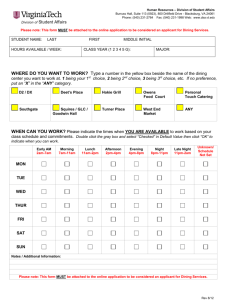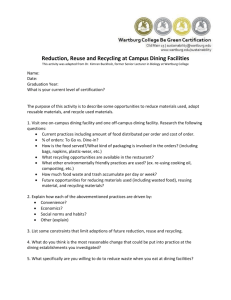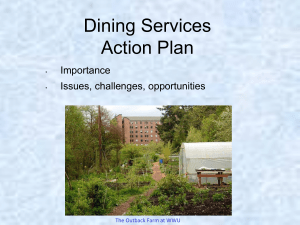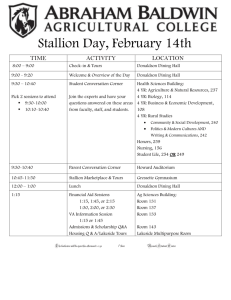How to Build and Run a Sustainable Dining Program
advertisement
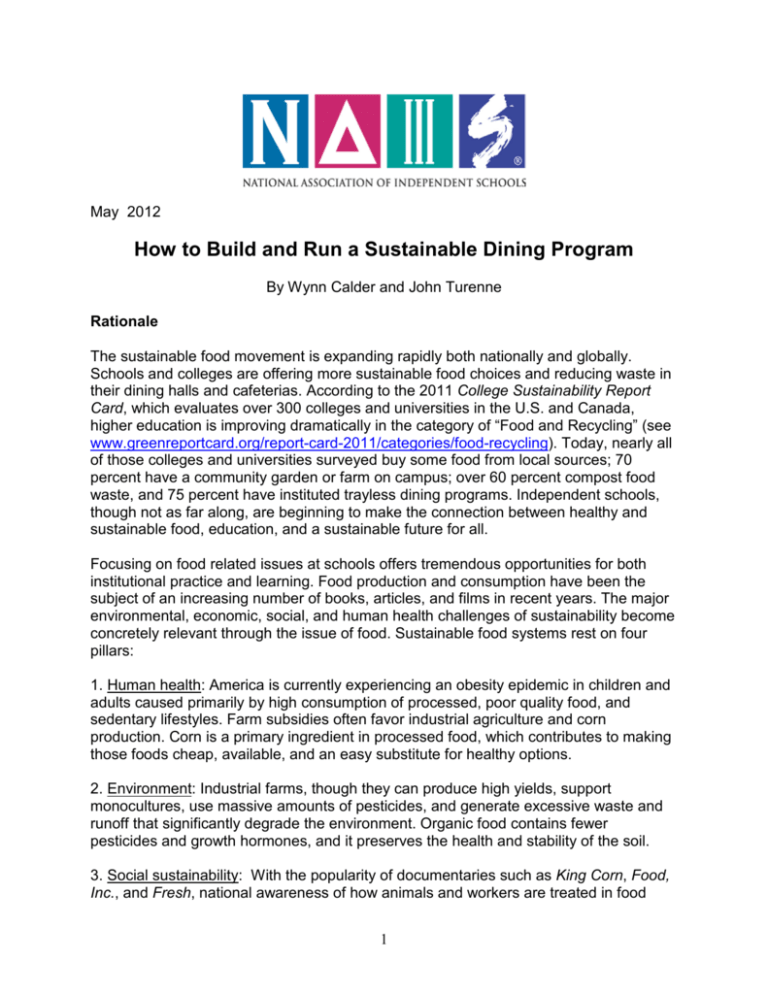
May 2012 How to Build and Run a Sustainable Dining Program By Wynn Calder and John Turenne Rationale The sustainable food movement is expanding rapidly both nationally and globally. Schools and colleges are offering more sustainable food choices and reducing waste in their dining halls and cafeterias. According to the 2011 College Sustainability Report Card, which evaluates over 300 colleges and universities in the U.S. and Canada, higher education is improving dramatically in the category of “Food and Recycling” (see www.greenreportcard.org/report-card-2011/categories/food-recycling). Today, nearly all of those colleges and universities surveyed buy some food from local sources; 70 percent have a community garden or farm on campus; over 60 percent compost food waste, and 75 percent have instituted trayless dining programs. Independent schools, though not as far along, are beginning to make the connection between healthy and sustainable food, education, and a sustainable future for all. Focusing on food related issues at schools offers tremendous opportunities for both institutional practice and learning. Food production and consumption have been the subject of an increasing number of books, articles, and films in recent years. The major environmental, economic, social, and human health challenges of sustainability become concretely relevant through the issue of food. Sustainable food systems rest on four pillars: 1. Human health: America is currently experiencing an obesity epidemic in children and adults caused primarily by high consumption of processed, poor quality food, and sedentary lifestyles. Farm subsidies often favor industrial agriculture and corn production. Corn is a primary ingredient in processed food, which contributes to making those foods cheap, available, and an easy substitute for healthy options. 2. Environment: Industrial farms, though they can produce high yields, support monocultures, use massive amounts of pesticides, and generate excessive waste and runoff that significantly degrade the environment. Organic food contains fewer pesticides and growth hormones, and it preserves the health and stability of the soil. 3. Social sustainability: With the popularity of documentaries such as King Corn, Food, Inc., and Fresh, national awareness of how animals and workers are treated in food 1 production has risen.. Purchasing fair trade products, by and large, brings social and economic benefits to small farmers in many parts of the world. 4. Sustainability of local communities: The most recent USDA census (2009) indicates that small farms in America are on the rise, reversing a decades-long trend toward the concentration of agriculture in massive industrial farms. Yet in today’s global food marketplace, fewer and fewer businesses are controlling more and more of the food we consume. Farmers markets, community supported agriculture (CSAs) and institutional relationships with local farmers and regional food distributors are helping bring economic vitality back to local communities. The major benefits of building sustainable food systems on campus include reductions in food waste, healthier and tastier food, increased support of food service, composting, gardening, and new opportunities for classroom learning. The following sections include: (a) a step-by-step guide to reforming and improving your food service; (b) some recommended resources; and (c) case examples from schools that have achieved great success in sustainable dining. The Five Spokes and Action Steps of Transforming Dining Services The shift to sustainable food is fundamentally about transitioning from quantity and convenience to quality and sustenance. Experience tells us that any enduring change requires a systemized approach. Imagine a successful sustainable food program as a wheel with five spokes: Community; Food; Facilities; Education; and Finances. If we want the wheel to perform to its optimum potential (and roll on to success), it requires all five spokes to support it and work collaboratively. If one or more spokes are neglected or not supporting to their capacity, the entire wheel will suffer. When all areas are systematically addressed, the opportunities are endless. 1- Community (A) Get buy-in from dining service staff. The best strategies include enlisting foodservers’ help, respecting their efforts, and giving them authority. Many food service staff feel constrained by regulations, budgets, contracts, facilities, and time pressures. Thus it is critical to engage the chef and other dining service staff in a conversation about what is possible, and to understand that significant improvements in your food system may require systemic change. (B) Identify a coordinator and form a task force to focus on the food initiative. The core team should include administration, faculty, students and, most importantly, members of the dining services staff. A simpler option is to appoint a two-person team: one representing the faculty and curriculum side, the other – the chef and/or director of food services – responsible for food service. Key questions for the team to pose: • What are our goals? 2 • What should we serve? How much processed food? How much real food? (You will need to limit food choices to save money and time. Fresh food requires more handling, and you will be cooking from scratch.) (C) Map out a vision of where you want to go and clarify the steps necessary to get there. Do background research on existing contracts and budgets, assign readings on sustainable food systems, and talk to administrators, teachers, students, and parents, as well as local chefs and farmers who might participate in the program. Clarify the food options that are preferable for your school community: Do you want to emphasize local or organic or both? Do you want to purchase only organic foods that are available in foodservice packaging and won’t require adjustments in terms of storage or preparation? Or do you want to offer fresh local and/or organic fruits, vegetables, or dairy products? Is it important to offer vegetarian or vegan alternatives? NOTE: If your school employs a large food contractor such as Sodexho or Aramark, it is important to investigate existing options with them. Though they have been slow to support sustainable/local food for their clients, this is changing and they will increasingly accommodate such demands. Bon Appétit, Sage, and other smaller contractors have typically supported healthy and sustainable food as part of their missions. (D) Consider forming a consortium with other schools in your region to make it economically viable to buy in bulk from local farmers. To ensure greater consistency and quality, it is often best to work through one or several regional distributors. (E) Work for local change and national reform. As the school community becomes more educated about food issues and related national legislation, invite students to weigh in and express their opinions to local decision makers, senators and congressional representatives. Programs such as the national farm-to-school effort, for example, have made a positive difference in communities around the country. 2- Food (F) Create a Wellness Policy that addresses nutritional expectations as well as the other pillars of sustainability. Make this policy part of the institution’s Policies & Procedures. Make it known to the school’s community and live by it. (G) Develop a food mission statement. This can both inspire and strengthen your commitment to sustainable food. (See Unquowa School example below.) (H) Audit menus and ingredients to ensure they abide by the minimal standards established in the Wellness Policy. (I) Visit local farms, businesses and vendors. Get to know the various growers and sellers of local/organic fruits, vegetables, and meats in your area and region. Over time, these relationships will be critical to the success of your program. Be prepared to try new ideas, work through challenges and obstacles, and look for long-term solutions. 3 (J) Consider making improvements outside of the dining hall: provide healthier choices in vending machines and in offerings at fundraising and special events (i.e., ban candy, junk food, sodas and bottled water). 3- Facilities (K) Ensure that the kitchen is equipped to service the type of menu your Wellness Policy dictates. Establish the best kitchen layout and equipment needs to process more food cooked from scratch. It is usually necessary to invest in processing equipment now in order to save in labor later. (L) Invest in energy and water saving upgrades such as replacing old equipment with new energy-efficient and water saving appliances and better waste disposal techniques. (M) Introduce recycling and composting. If it’s not already in place, integrate comprehensive recycling into your dining services operation. Start a composting program that can provide fertilizer to school grounds and/or garden. Shift to reusable serviceware and non-toxic cleaners. (N) Consider starting a vegetable garden on campus. A garden can be an excellent teaching tool as well as supplement the school menu throughout the year. 4- Education (O) Provide training for your food staff in healthy and sustainable food: Why is fresh, whole food important to the community and the institution? How is fresh food handled? (P) Institute regular awareness raising and information dissemination about your school’s commitment to a healthy and sustainable food program. Engage in periodic activities beyond the dining hall that support the mission and purpose of your food initiative. These include hands-on cooking demonstrations and recipe testing, field trips to farms, and testing compost plans with science teachers and dining services staff. Invite local farmers and vendors to visit the school to talk about their craft. As some schools have done, hold regular “chats” with the chef during lunch where they tell the “story” the meal (sources and history of the foods, etc.). This never fails to inform and inspire those present. (Q) Bring food issues into the curriculum where appropriate and at different grade levels. Provide education about the food system and its history, industrial agriculture, small farmers, production and distribution, and how individuals and communities can be part of the national debate and make informed choices about what they buy. (R) Stay up to date on developments in the field. Sustainable, local, organic, and fair trade food options and regulations are evolving quickly, and you will be able to improve your program more effectively if the coordinators/task force stay informed. 4 (S) Learn from your successes and failures and conduct regular assessments. One effective tool is the S.W.O.T. analysis (Strengths, Weaknesses, Opportunities & Threats). This enables the school to celebrate successes, make improvements and anticipate potential threats over time. (T) Involve students in menu choices and others aspects of the program. Students will embrace the program more enthusiastically if they can take part in creating it, from food options, to food preparation, to visiting farms, to gardening. 5- Finances (U) Be creative about how money is spent and look for opportunities to save. Funding is always a concern. We offer several ways of thinking about this: • If you take this one step at a time and are careful about your choices, it is possible to break even on cost. • Some schools have found that serving fewer high quality options (organic, local, fresh, etc.) is better and cheaper than offering more options, which is a typical response to complaints about food quality. • There are usually ways to make small one-time investments now in order to reap savings later. These include proper staff training on recipe development, menu writing, technical skills such as food preparation, as well as the education on ‘why’ it is important to change food service to be more sustainable. • Look to eliminate individual packaging, therefore switching to more bulk purchasing. Not only is bulk often less expensive; you’ll cut down on waste, resulting in less trash removal/tipping fees. • Get rid of small containers/packaging of conventional foods and replace these with organic options in bulk. Milk, often served in ½ pint containers in lower schools, is a common example. • Look at ways that better processing equipment can save on labor. New investment now may save later. • Focus on proper food production forecasting and planning to eliminate over production/ wasted food. • Be sure to utilize detailed weekly or monthly operating reports that monitor inventory, food consumption, food and labor costs. Use these reports to monitor your weekly or monthly operating expenses so as to make adjustments, locate higher expenditures for adjustments or savings for reinvestment. • Most sustainable food programs have resulted in better health of staff, therefore reduction in missed time. In addition, motivation increases when staff begin practicing a skill they enjoy and are proud of. • Consider trayless dining (see example from St. Paul’s School below). • We pay for what we care about. If sustainable and healthy food matters to your school, then the investment will pay off manifold. Resources 5 NAIS – NAIS has many sustainability resources, including examples of schools that are excelling in the sustainable food arena. More at www.nais.org/go/green. The Edible Schoolyard – The mission of the Edible Schoolyard at Martin Luther King, Jr. Middle School is to create and sustain an organic garden and landscape that is wholly integrated into the school's curriculum and lunch program. It involves the students in all aspects of farming the garden – along with preparing, serving and eating the food – as a means of awakening their senses and encouraging awareness and appreciation of the transformative values of nourishment, community, and stewardship of the land. www.edibleschoolyard.org/about.html Rethinking School Lunch (RSL) Guide – The RSL guide contains tools and creative solutions to the challenges of improving school lunch programs, academic performance, ecological knowledge, and the well-being of our children. In its chapters, experts and practitioners highlight goals and challenges, showcase success stories, and offer resources for further exploration. www.ecoliteracy.org/programs/rsl-guide.html Sustainable Food Systems Curriculum – To increase basic food literacy and give consumers a more sophisticated understanding of the economics of our food system options, health and food quality issues, effects of the food system on rural communities, and the history of our regional food system. http://round-river.com/curriculumhome.html Sustainable Table – Extensive online resource on the sustainable food movement including information on cafeterias, school gardens and other food projects, and database to find local and sustainable meat, dairy and eggs. www.sustainabletable.org Case Examples (A) Promoting Sustainable and Local Food at The Unquowa School (Fairfield, CT) Sharon Lauer, head of school, slauer@unquowa.org and John Turenne, president and founder, Sustainable Food Systems, jturenne@sustainablefoodsystems.com. www.unquowa.org. The Unquowa School launched a sustainable dining program in 2005 with the goals of improving nutrition, reducing waste, and supporting the local economy. Working with an outside consultant, school staff met with local farmers and vendors, developed a mission statement, and worked with the school community and parents to raise awareness and gain buy-in. To date, Unquowa’s family style dining program achievements include reduction in waste, creation of a kitchen garden, a composting program, better food quality and freshness (with organic milk, vegetables, and local cage-free eggs), and incorporation of food awareness and hands-on work into the curriculum. Their mission statement, developed in 2005, reads: “To provide a 6 nutritionally balanced, good tasting, environmentally and fiscally responsible menu that utilizes local, sustainably produced and quality ingredients.” Cost per meal: • $1.70 per meal while increasing local and organic purchasing to a level of approximately 45 percent. Note: Many schools running conventional programs are paying $1.95 or more per meal. Factors contributing to cost savings: • Change in packaging from individual to bulk (for example, serving organic milk from gallon containers rather than regular milk from individual-sized containers; morning snacks in large rather than individual bags). • Direct purchasing of a few items (such as beef) that control the chance of mark-up from a distributor. • Scratch cooking, utilization of all ingredients. • Annual sustainable foodservice strategic planning session of the entire team: chefs, head of school, finance, and faculty liaison. • Strong implementation of weekly and financial operating and production systems (invoice, inventory, and operating reports), which allows better control and monitoring of financial performance by constantly comparing weekly results against forecasted plan, and adjusting as we go. Additional improvements to the program: • Menu structure hasn’t changed in terms of number of entrees. Salad bar choices have increased. • Addition of a floor mixer to make bread dough for homemade bread and pizza dough. • Biggest financial investments have been in staffing: o Hiring of an experienced, scratch-cooking chef. o Addition of a full-time similarly experienced cook. Unquowa’s sustainable food program is an example of nearly breaking even financially while improving the health and quality of our food and enhancing the education of children, faculty, and staff. Where we save money in some areas, we reinvest it in others to improve the program and instill lifelong habits of good stewardship. For the first few years of the new system, we made it work on our existing budget. Though we increased our budget gradually over the following few years we have continued to stay close to our original costs. (B) Going Trayless in the Cafeteria at St. Paul’s School (NH) Maura Adams, environmental stewardship manager, madams@sps.edu and Kurt Ellison, food services director, kwellison@sps.edu. www.sps.edu. In an effort to combat the problem of food waste, St. Paul’s School experimented with trayless food services for three weeks during their five week Summer Program in 2007. 7 We carefully considered the pros and cons and felt that the pros far outweighed the cons. Cons: • Convenience – One must walk more. • Time consumption – One must walk more. • Table condition – Without the tray to catch spills, tables can get messy. • Parents with small children – Will most likely have difficulty navigating without trays; must make sure they are available. Pros: • Waste reduction – This was greater than expected. • Food purchasing, kitchen production reduction – Reduction in waste directly impacted food purchases and kitchen production. • Dish room labor reduction – Going trayless has freed up one person. • Water and chemical reduction – Trays alone account for one-third of the water and chemical use. • People eat less – If you don’t have it in front of you, you’re not as tempted to eat it. Lessons learned: • Total faculty and staff support is necessary before beginning the initiative. • The first year we made it optional for the students, however, we had about 95 percent participation from the student body. Only the older boy athletes insisted on using a tray. The second year we required full participation and only had trays available for parents with small children and for injured students who had friends helping them with their meals. • We also learned that the correct placement and abundance of silverware is critical. • Water should be provided in the dining room for beverage replenishment, either with pitchers, Poland Spring dispensers, or plumbed water bubblers. • More attention needs to be paid to cleaning the tables during the meals. Savings: In the first 12 weeks of trayless dining, • We saved nearly $16,000 in food purchases as compared to the same period the year before. The savings in milk totaled 685 gallons or nearly 11,000 glasses. We saved more than 1,300 gallons of juice or the equivalent of 21,000 glasses. Total for all beverages was 11,093 gallons or 177,500 glasses. The savings in cereal amounted to 43 cases or 5,700 bowls, and we used 8,200 fewer eggs for a savings of 690 dozen. • We saved about 1,100 gallons of water per day, which is over 261,000 gallons in a school year or more than 4 million glasses of water. Reinvestment and improvement: Savings from the reduction of food waste has been totally reinvested in the dining program. We’ve added three stir-fry stations to the dinner meal seven nights a week as well as a smoothie bar seven mornings a week. Except for these and a few other 8 additions, the beverage and menu choices have remained the same. For St. Paul’s School, going trayless has been a win-win decision. EDITOR’S NOTE: Kurt Ellison stands by these numbers today. More recently St. Paul’s has transitioned to total “self-service” and has reached another level of food waste savings. About the Authors: Wynn Calder is a consultant to NAIS on sustainability and director of Sustainable Schools, LLC, a consulting group the helps schools and colleges improve their teaching and practice of sustainability. Wynn can be reached at wynn@sustainschools.org. John Turenne is president and founder of Sustainable Food Systems, LLC, (www.sustainablefoodsystems.com), a consulting and technical services company that transforms institutional food programs to be more healthy and sustainable. John can be reached at jturenne@sustainablefoodsystems.com. 9
